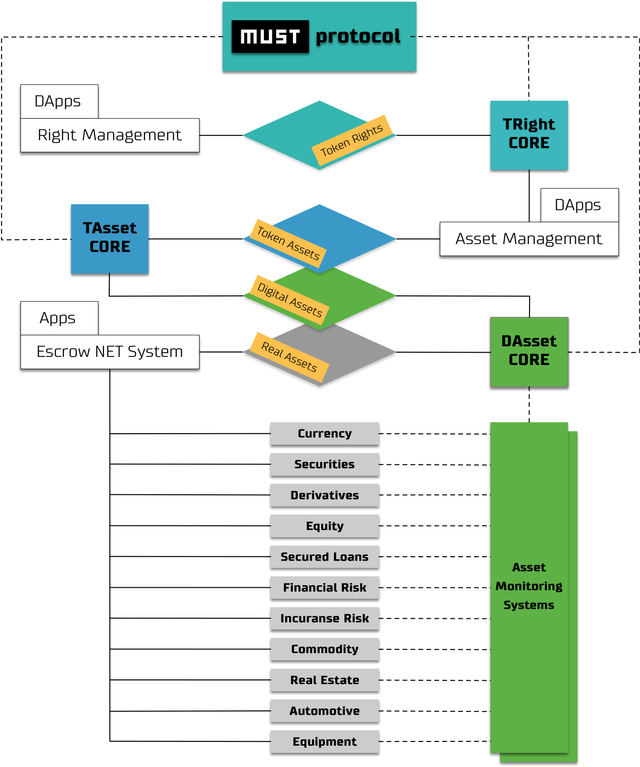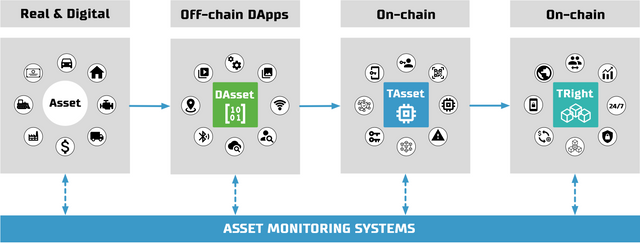MUST Protocol: Asset and Rights Management in the Digital Economy
The essence of each economic transaction is the exchange of rights to own, use or dispose of assets. Tokenization of rights to assets will ensure the formation of new trusted mechanisms and ways of economic interaction, built on the principles of decentralization.
The asset right token that is issued in linkage to a particular type of asset is a new type of asset that exists in the digital field. You can tokenize any class of assets, both illiquid and liquid: fiat money, stocks, bonds, transport, equipment, real estate and more.
The benefits of tokenization of asset rights:
- decentralized system for sharing access rights to asset information;
- separate ownership of certain types of rights to the asset;
- ease of sale and acquisition of rights to the asset;
- unchangeability of information about the asset and related market participants;
- encryption of information and protection against unauthorized access;
- flexibility of customization and automation of business logic using smart contracts.
With the help of MUST Protocol it is possible to check the proof of the existence of the rights to the asset without the participation of third parties, to alienate, acquire or pledge the rights to the asset or transfer rights to such rights.
Within the MUST Protocol, storage, management and exchange of tokenized rights to assets are decentralized processes in the blockchain network, which ensures their 24/7 availability. Asset management systems built using asset rights tokenization technology will ensure a multiple growth in asset utilization efficiency, shorter decision-making times, reduced risks and management costs.

Mechanics of transactions
Tokenization of rights to the asset fundamentally changes the mechanics of transactions with this asset. For example, the asset [apartment] receives the following types of rights tokens after tokenization:
*Right of ownership
*Right of disposal
*Right of use
After the tokenization of rights, the owner of the asset will receive 3 non-fungible tokens to his crypto wallet (at the initial stage these will be the ERC721 standard NFTs in the Ethereum network):
*TRight [Ownership]
*TRight [Disposal]
*TRight [Use]
Tokenization of the right to use a shopping center TRight [Use] will allow its owner to attract financing by offering these tokens to investors in a similar way to bonds secured by future cash flow. Acquiring the use right tokens TRight [Use], investor will receive revenue from the lease of retail space, proportional to the number of purchased tokens.
Ownership rights tokenization TRight [Ownership] will provide the possibility of a partial sale of ownership of the asset, for example, a production facility of the owner, who wants to attract financing while retaining the right to use the asset — TRight [Use]. By purchasing an ownership right token TRight [Ownership], an investor will be able to easily acquire part of the asset, which increases the liquidity of the asset.
Applications
MUST Protocol will grant a wide range of users with a comprehensive solution that can provide a full-fledged transition of values from the real world to the digital one by tokenizing all types of asset rights. The protocol includes the stages of verification, digitization, complex criterial evaluation, monitoring of the asset’s status, identification of holders of rights to this asset and the tokenization of rights. This approach will ensure the possibility of forming a digital ecosystem for participants in a real economy built on the exchange of tokenized asset rights.
Management of personal assets | Individuals
Tokenization of rights to own assets will significantly increase their liquidity and provide an opportunity to derive additional benefits from the user-owned low-liquid assets (car sharing, Airbnb-like property rental). At the same time, security of transactions will be guaranteed by decentralized escrow smart contracts.
Debt and Liability Management | Banks, Individuals, Organizations
With the help of services built on the basis of MUST Protocol, individuals, entrepreneurs and organizations will be able to place, sell, buy and conduct netting of rights and obligations (including debts). All information about the creation, structuring and confirmation of compliance with regulatory requirements, performance records and any other accompanying information is homogenized (uniformed) and stored in chronological order in a series of events. This will change the debt market, make it open and accessible to a large number of new players, and will simplify the relations of creditors and debtors.
Fund raising| Micro, Small and Medium Business
Tokenization of rights to illiquid assets allows to achieve the same economic effect as securitization. That is, an illiquid asset is transformed into a liquid asset, which gives an opportunity to attract financing from the open market. Micro, small and medium-sized enterprises will have access to debt financing on beneficial terms without intermediaries.
Risk Management | Banks, Leasing and Insurance Companies
Tokenized asset rights will become the basis for the formation of a new risk assessment and management system. A high degree of reliability and invariability of information about the real state of assets will form the basis of new fintech products and services for banks, leasing and insurance companies.
Management of toxic assets | Banks, MFIs, Leasing companies
Tokenization of toxic assets and rights to such assets will ensure the formation of new interaction mechanisms for market participants. Seeking a buyer for toxic assets will take less time, the cost of sales will increase substantially due to the completeness of information about the asset and the ease of its authentication.
New financial market | Brokers, Investors, Investment funds
Financial instruments built on tokenized rights to real-market assets will be a new stage in the development of the economy. The connection of TRight tokens with real assets will ensure a high degree of transparency and predictability of risks. Investors, brokers, stock exchanges and insurance companies will have access to transparent and reliable information about the real state of tokenized assets.
Asset Management and Economic Performance | Corporations
Companies that own large portfolios of assets will receive new effective management tools. Tokenized assets management systems will provide a significant reduction in transaction costs and costs associated with updating and verification of information on the real state and economic indicators of portfolio assets.
Control over assets and enforcing obligations
Most people consider tokenization by the process of releasing a token on a public blockchain. However, when we talk about the tokenization of rights to real assets, the situation is much more complicated. The release of the token is no more than 5% of the entire process, the remaining 95% is the collection and confirmation, as well as the storage and protection of information about the asset, as well as rights and owners of rights to this asset.
According to most international blockchain and digital economy experts, asset tokenization becomes meaningful only if the asset right token has a permanent and two-way connection with the asset in the real world.
To accomplish this task, the MUST Protocol project team uses a comprehensive approach that develops high-performance on-chain and off-chain rules and methods that ensure the necessary level of relevance and reliability of information.

The current level of automation of processes does not allow to refuse from human participation. For example, when inspecting an asset, assessing it, preparing reports for the tax service, filing registration documents with respect to state registers and in many other cases.
In order to ensure a high degree of decentralization, verifiability and quality of the performance of a single performer, MUST Protocol suggests using the Escrow DAO (Decentralized Autonomous Organization) network of smart contracts for all roles in the system — Escrow NET. It is formed from a large number of smart contracts Escrow DAO, designed to ensure the security of all types of transactions and to guarantee the protection of the rights of all participants of various platforms based on MUST Protocol.
Escrow DAO is a service, a set of smart contracts that simultaneously provide the distribution of tasks among the participants of the DAO, participate in the distribution of payments and guarantee the security of mutual settlements to all parties to the transaction.
Each single Escrow DAO smart contract is a kind of hub for connecting a large number of private users within one particular function of the platform. For example, Escrow DAO unites lawyers who receive tasks on audit and maintenance of transactions of state registration of the real estate objects ownership or Escrow DAO for insurance agents.
Each separate Escrow DAO provides the function of the Auditor, who has the right to initiate disputes regarding the quality of work performed by other platform participants. At the same time, the Auditor himself does not participate in audit processes under any circumstances, and all performers are appointed automatically, which excludes the possibility of collusion at the audit stage.
Thus, Escrow NET is a kind of system of mediation (balancing) of rights and obligations, which can provide the formation of a new model of legal relations between the participants of platforms built on the basis of MUST Protocol, which is based on the principle of the inevitability of the deal.